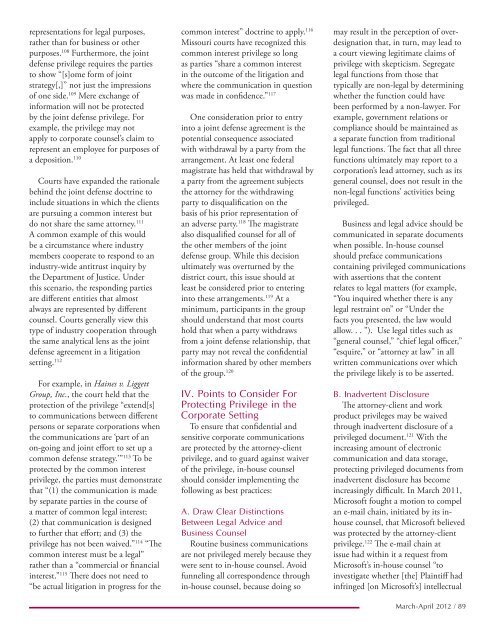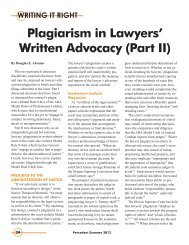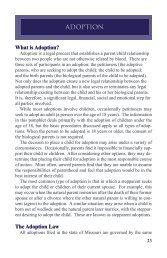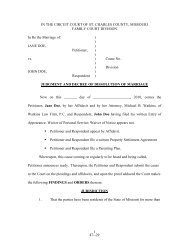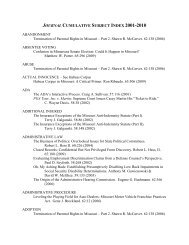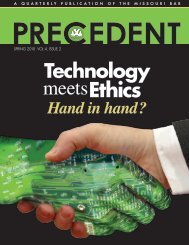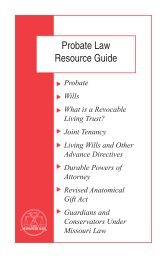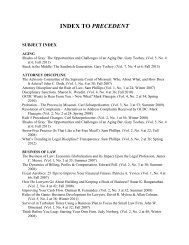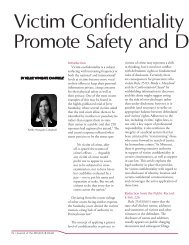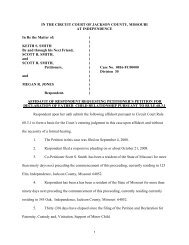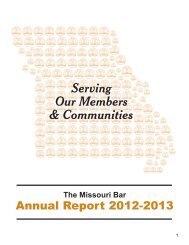An Essential Guide to Attorney-Client Privilege ... - the Missouri Bar
An Essential Guide to Attorney-Client Privilege ... - the Missouri Bar
An Essential Guide to Attorney-Client Privilege ... - the Missouri Bar
- No tags were found...
You also want an ePaper? Increase the reach of your titles
YUMPU automatically turns print PDFs into web optimized ePapers that Google loves.
epresentations for legal purposes,ra<strong>the</strong>r than for business or o<strong>the</strong>rpurposes. 108 Fur<strong>the</strong>rmore, <strong>the</strong> jointdefense privilege requires <strong>the</strong> parties<strong>to</strong> show “[s]ome form of jointstrategy[,]” not just <strong>the</strong> impressionsof one side. 109 Mere exchange ofinformation will not be protectedby <strong>the</strong> joint defense privilege. Forexample, <strong>the</strong> privilege may notapply <strong>to</strong> corporate counsel’s claim <strong>to</strong>represent an employee for purposes ofa deposition. 110Courts have expanded <strong>the</strong> rationalebehind <strong>the</strong> joint defense doctrine <strong>to</strong>include situations in which <strong>the</strong> clientsare pursuing a common interest butdo not share <strong>the</strong> same at<strong>to</strong>rney. 111A common example of this wouldbe a circumstance where industrymembers cooperate <strong>to</strong> respond <strong>to</strong> anindustry-wide antitrust inquiry by<strong>the</strong> Department of Justice. Underthis scenario, <strong>the</strong> responding partiesare different entities that almostalways are represented by differentcounsel. Courts generally view thistype of industry cooperation through<strong>the</strong> same analytical lens as <strong>the</strong> jointdefense agreement in a litigationsetting. 112For example, in Haines v. LiggettGroup, Inc., <strong>the</strong> court held that <strong>the</strong>protection of <strong>the</strong> privilege “extend[s]<strong>to</strong> communications between differentpersons or separate corporations when<strong>the</strong> communications are ‘part of anon-going and joint effort <strong>to</strong> set up acommon defense strategy.’” 113 To beprotected by <strong>the</strong> common interestprivilege, <strong>the</strong> parties must demonstratethat “(1) <strong>the</strong> communication is madeby separate parties in <strong>the</strong> course ofa matter of common legal interest;(2) that communication is designed<strong>to</strong> fur<strong>the</strong>r that effort; and (3) <strong>the</strong>privilege has not been waived.” 114 “Thecommon interest must be a legal”ra<strong>the</strong>r than a “commercial or financialinterest.” 115 There does not need <strong>to</strong>“be actual litigation in progress for <strong>the</strong>common interest” doctrine <strong>to</strong> apply. 116<strong>Missouri</strong> courts have recognized thiscommon interest privilege so longas parties “share a common interestin <strong>the</strong> outcome of <strong>the</strong> litigation andwhere <strong>the</strong> communication in questionwas made in confidence.” 117One consideration prior <strong>to</strong> entryin<strong>to</strong> a joint defense agreement is <strong>the</strong>potential consequence associatedwith withdrawal by a party from <strong>the</strong>arrangement. At least one federalmagistrate has held that withdrawal bya party from <strong>the</strong> agreement subjects<strong>the</strong> at<strong>to</strong>rney for <strong>the</strong> withdrawingparty <strong>to</strong> disqualification on <strong>the</strong>basis of his prior representation ofan adverse party. 118 The magistratealso disqualified counsel for all of<strong>the</strong> o<strong>the</strong>r members of <strong>the</strong> jointdefense group. While this decisionultimately was overturned by <strong>the</strong>district court, this issue should atleast be considered prior <strong>to</strong> enteringin<strong>to</strong> <strong>the</strong>se arrangements. 119 At aminimum, participants in <strong>the</strong> groupshould understand that most courtshold that when a party withdrawsfrom a joint defense relationship, thatparty may not reveal <strong>the</strong> confidentialinformation shared by o<strong>the</strong>r membersof <strong>the</strong> group. 120IV. Points <strong>to</strong> Consider ForProtecting <strong>Privilege</strong> in <strong>the</strong>Corporate SettingTo ensure that confidential andsensitive corporate communicationsare protected by <strong>the</strong> at<strong>to</strong>rney-clientprivilege, and <strong>to</strong> guard against waiverof <strong>the</strong> privilege, in-house counselshould consider implementing <strong>the</strong>following as best practices:A. Draw Clear DistinctionsBetween Legal Advice andBusiness CounselRoutine business communicationsare not privileged merely because <strong>the</strong>ywere sent <strong>to</strong> in-house counsel. Avoidfunneling all correspondence throughin-house counsel, because doing somay result in <strong>the</strong> perception of overdesignationthat, in turn, may lead <strong>to</strong>a court viewing legitimate claims ofprivilege with skepticism. Segregatelegal functions from those thattypically are non-legal by determiningwhe<strong>the</strong>r <strong>the</strong> function could havebeen performed by a non-lawyer. Forexample, government relations orcompliance should be maintained asa separate function from traditionallegal functions. The fact that all threefunctions ultimately may report <strong>to</strong> acorporation’s lead at<strong>to</strong>rney, such as itsgeneral counsel, does not result in <strong>the</strong>non-legal functions’ activities beingprivileged.Business and legal advice should becommunicated in separate documentswhen possible. In-house counselshould preface communicationscontaining privileged communicationswith assertions that <strong>the</strong> contentrelates <strong>to</strong> legal matters (for example,“You inquired whe<strong>the</strong>r <strong>the</strong>re is anylegal restraint on” or “Under <strong>the</strong>facts you presented, <strong>the</strong> law wouldallow. . . ”). Use legal titles such as“general counsel,” “chief legal officer,”“esquire,” or “at<strong>to</strong>rney at law” in allwritten communications over which<strong>the</strong> privilege likely is <strong>to</strong> be asserted.B. Inadvertent DisclosureThe at<strong>to</strong>rney-client and workproduct privileges may be waivedthrough inadvertent disclosure of aprivileged document. 121 With <strong>the</strong>increasing amount of electroniccommunication and data s<strong>to</strong>rage,protecting privileged documents frominadvertent disclosure has becomeincreasingly difficult. In March 2011,Microsoft fought a motion <strong>to</strong> compelan e-mail chain, initiated by its inhousecounsel, that Microsoft believedwas protected by <strong>the</strong> at<strong>to</strong>rney-clientprivilege. 122 The e-mail chain atissue had within it a request fromMicrosoft’s in-house counsel “<strong>to</strong>investigate whe<strong>the</strong>r [<strong>the</strong>] Plaintiff hadinfringed [on Microsoft’s] intellectualMarch-April 2012 / 89


